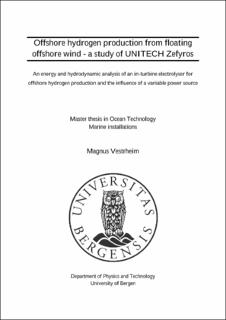| dc.description.abstract | The aim of this thesis is to review design considerations and study the effect of a variable power supply of offshore hydrogen production by an electrolyser inside the turbine tower of a floating offshore wind turbine. To achieve this, UNITECH Zefyros, previously known as Hywind Demo, the world’s first floating offshore wind turbine, has been studied for the possibility of hydrogen production. Historical 2020 wind and power data collected by Zefyros are used for calculations in the thesis. The thesis is divided into two cases, shown below. • Case 1 An in-turbine electrolyser to show the feasibility of hydrogen production at UNITECH Zefyros. • Case 2 A large-scale hydrogen production system to study the effect of an intermittent power supply from wind power on an electrolyser. The chosen electrolyser must comply with the space constraints in the turbine tower, resulting in a low-rated electrolyser, less than 1 % of the turbine’s rated power. Hence, the electrolyser will operate at its rated load if the turbine generates power and cannot be used to study how variable power influences the electrolyser. A second hydrogen production system is thus proposed, where the constraints regarding space inside the turbine tower are not considered. This facilitates for an electrolyser that can use all available energy from Zefyros for hydrogen production, making the load profile dynamic. For case 1, an in-turbine hydrogen production system is proposed, where the components are reviewed for compatibility in an offshore environment. Safety considerations introduced by in-turbine hydrogen production are identified. Zefyros’ responses to 1- and 10-year seas are estimated to identify what displacement and accelerations an in-turbine electrolyser would experience. The annual hydrogen yield in 2020 from the in-turbine electrolyser is estimated. For case 2, a model is developed in which the electrolyser’s energy efficiency is estimated through the cell voltage. The energy efficiencies throughout 2020 and the annual hydrogen yield are estimated to show the effect a variable power source has on an electrolyser. | |
